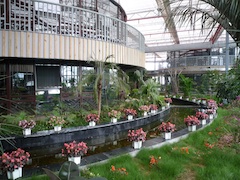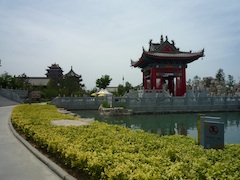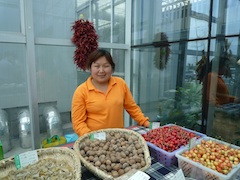| |
|
 |
Chinese green pilgrimage city transformed by huge investment
May 23, 2012:
 |
 |
 |
The Louguan Daoist Spa Hotel combines luxury rooms with low-carbon heating and Daoist principles. |
Green Pilgrimage City Louguan brings modern green technology to ancient Daoist principles.
A team from ARC has had the privilege of visiting the impressive new development in China
Eighteen months of building and a $1.5 billion investment from individuals and the Chinese government has seen an amazing transformation at the new pilgrimage city of Louguan, near Xian in western China.
The mountain area of Louguan - which is the site where the sage Lao Zi is said to have written the Dao De Jing in a single night - has been declared an ecological conservation area and around 30,000 people are currently being rehoused from the slopes of the Qinling mountains to ‘re-green’ the mountain – allowing reforestation and providing a better habitat for biodiversity. The whole complex, situated at the birthplace of Daoism, is being billed as an inspirational model for sustainable living- where people can live in harmony with nature in an ideal garden-like small city.
In 2011 Louguan formally joined the Green Pilgrimage Network in Assisi.
Housing and Building
Modern low rise sustainable housing has been built in Louguan in tree-lined streets using natural gas and solar power heating. New public building includes the Louguan Daoist Spa Hotel- built with key Daoist concepts and offering luxury rooms, open air bath pools in its bamboo groves and fish pedicures as well as a state of the art conference centre. Housed in a cluster of glass buildings there’s also an organic restaurant serving local food and a vegetable growing demonstration site- all heated by solar and natural gas with low carbon emissions.
Temple complexes
There are two vast Daoist temple parks with 3D presentations of Daoism and its rituals, ancestor worship and gods – all laid on from the comfort of electric buggies and with smartly dressed guides. The God of Wealth Temple Complex is a 3.5 square kilometre park showing the legends and stories of gods, folk dances and music related to the God of Wealth. It opened in July 2011.
 |
 |
 |
Newly constructed Daoist temples celebrate the teachings of Lao Zi |
The temples are so high that there are elevators to each of the storeys – one lift stopping at the main shrine for the God of Wealth, another at a worship area and another at a display centre for God of Wealth Culture. Daoist teaching is everywhere as are stands to dress up in traditional dress for photos.
Then there’s the Daoist Culture Exhibition Area with its 13 newly constructed Daoist temples, its nine courtyards and 6 palaces making this the world’s largest and grandest Daoist palace complex- where visitors and pilgrims alike enter the divine world of the immortals. The largest hall is 32 metres high- with a shimmering gold roof, supported by vermillion pillars and built with doors and windows decorated in gold and jade. The Halls lead up to a preaching platform built on the place where Lao Zi taught the Dao De Jing. A solid gold statue of Lao Zi has just been erected.
Another enormous complex designed for women, demonstrating Daoist tea culture and spring water culture, is almost complete.
Organic Farming
 |
 |
 |
Organic produce on display |
In 46 hectares of development, there is also an agriculture expo centre where organic farming, sustainable land management techniques and new farming methods are taught. Many of the rehoused new residents of the city are being taught new ways to farm, for example, roses and lavender or how to grow kiwi seeds imported from Singapore which grow faster and don’t damage the land. Natural fertilisers are used- with leaves and branches being ground into powder for fertislisers to increase the output of the land in a sustainable way.
Three Sticks
There were signs of pilgrimage at many of the temples – the trees strewn with red ribbons and prayer requests and many of the bunches of incense being burnt were in three sticks according to the Daoist 8 Year Environment Plan.
Teachings
The teaching of Daoism on living in harmony with nature and on the importance of protecting nature is also evident with the demonstration of traditional ceremonies associated with the seasons to try and reconnect urban dwellers with the rhythms of the year. For example, local festivals are now being held for the return of the snow or the return of the mosquitoes where people are being re-taught old practices of heating up a special leaf that has an aroma to dispel mosquitoes.
Replication and Inspiration
Our municipal guides told us that they would like to see the success of Louguan’s development replicated in other cities in China. The Daoist Master Ren of Lougandai Temple told us that this was a return to spiritual values, to living a simple life, based on Daoist teaching of living in harmony with nature and with each other.
Useful inks for more information
Green Pilgrimage Network
Louguan Daoist Temple
Assisi conference 2011
Daoism and Ecology
|
 |
 |
|
|
|
|
|

